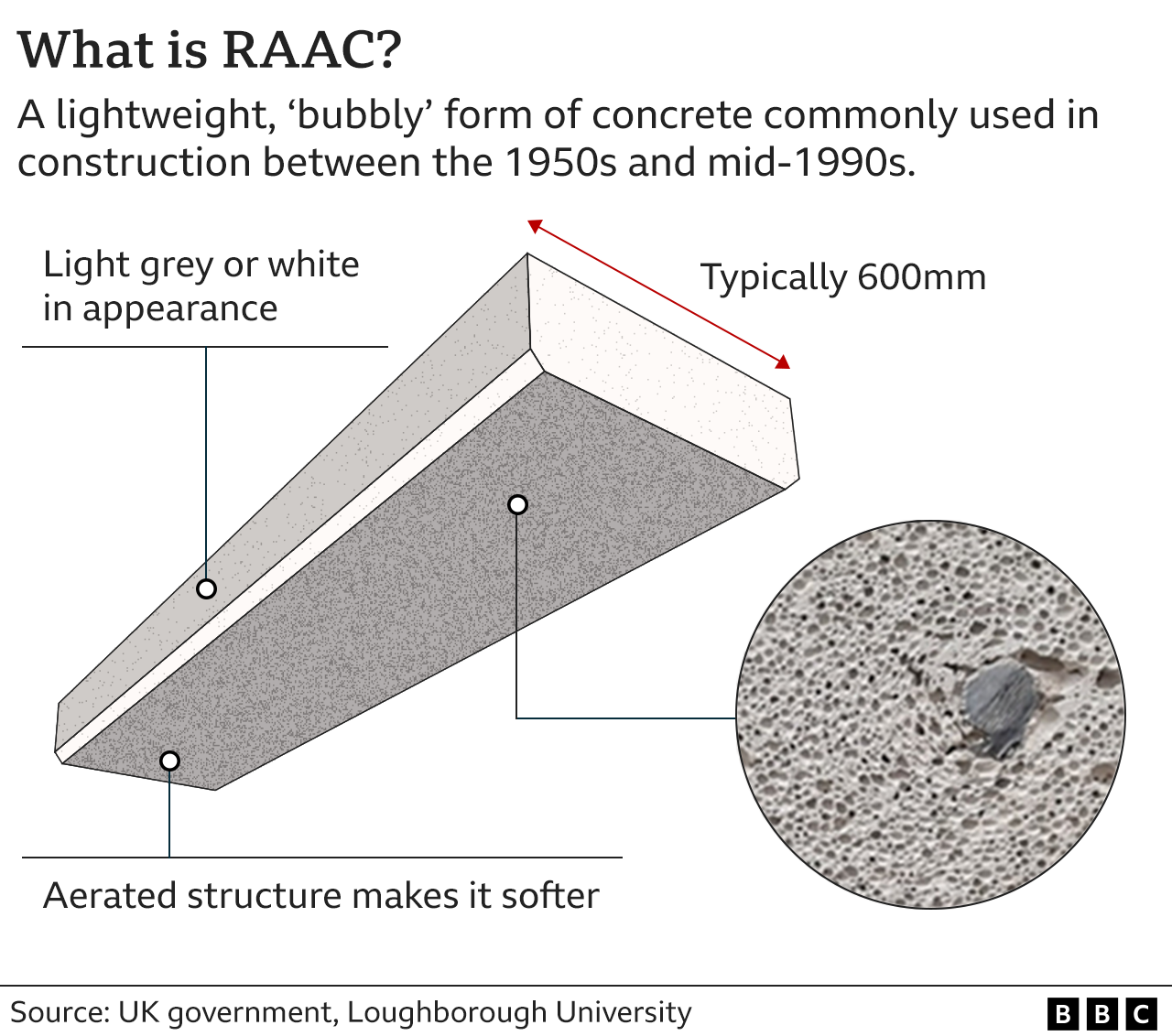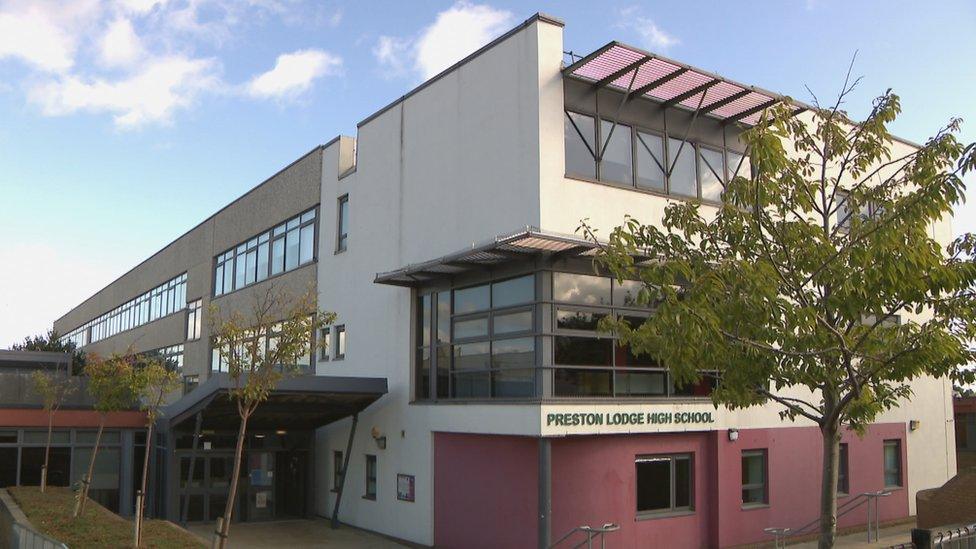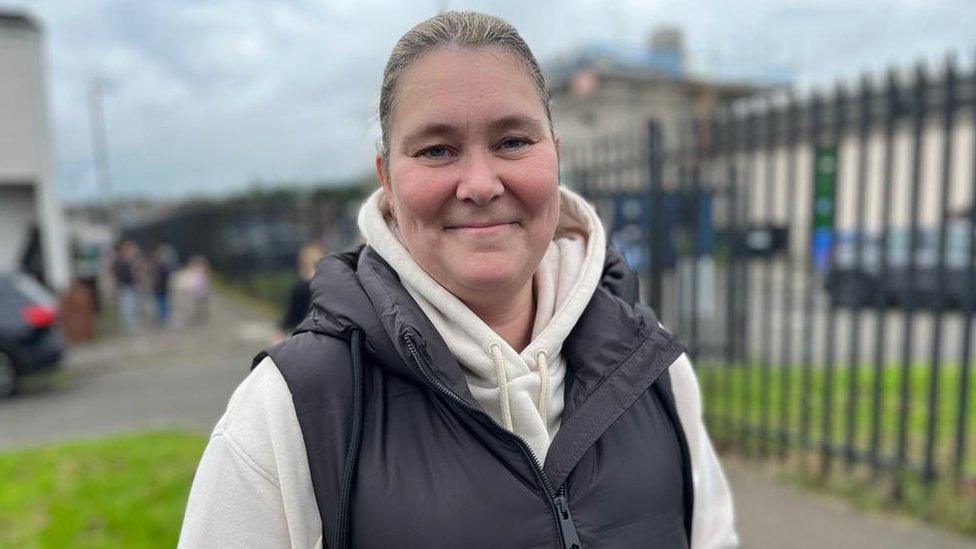Concrete-risk wall secured from collapse at Scottish school
- Published
The Scottish education secretary says only a "relatively small" number of Scottish schools are affected
The Scottish government has confirmed a wall containing collapse-risk concrete had to be secured at a Scottish school.
A total of 35 council-run schools have been found to contain reinforced autoclaved aerated concrete (RAAC).
Education Secretary Jenny Gilruth said the incident happened at an MoD school - the only one of which is the private Queen Victoria school in Dunblane.
More than 100 schools in England have been told to close areas of their buildings that have RAAC.
Ms Gilruth said councils across Scotland were carrying out assessments, with all expected to report back by next week.
Architect Colin Meikle explains what RAAC is, what the problem with it is, and why and when it was used
She told BBC Scotland's Drivetime radio programme: "There was not a collapse, as far I understand it.
"Instead, the wall was made secure on further inspection."
The minister added: "The total number of schools in Scotland affected is 35, so a relatively small number in comparison to the overall school estate which is around 2,500 schools.
"Our schools are safe. It's really important to say our local authorities have sought to provide me with reassurances throughout the course of the last few months."
The Scottish government has said that where RAAC is found, remedial work could include the closure of impacted rooms or sections of the building and the use of temporary, modular provision for pupils to ensure the continuity of education.
It has also stressed that pupils will not be taught in the parts of buildings where the concrete is considered a risk.
RAAC is a lightweight concrete that was used in roofs, floors and walls between the 1950s and 1990s.
It is a cheaper alternative to standard concrete and because it's aerated, or "bubbly", it is less durable with a limited lifespan of around 30 years.
The Health and Safety Executive says RAAC is now beyond its lifespan and may "collapse with little or no notice", with a collapsed beam over the summer making the UK government aware that more schools in England were at risk than had previously been thought.
A Scottish government ministerial group was set up when RAAC issues were originally raised.
Jenny Gilruth said: "I have a list of schools that are impacted in Scotland, and the mitigations that our local authority partners have put in place will now be considered by officials in Scottish government.
"We'll look to interrogate some of that data a bit further and also provide reassurance to parents and carers.
"I think it's really important that our local authorities, who have a statutory responsibility for the delivery of education locally, engage directly with our parents and carers."

BBC Scotland News has contacted all of Scotland's 32 councils to ask whether any of their schools contained RAAC.
Of those who have responded so far, West Lothian Council said it has been found at five primary schools and four community centres.
It has also been identified at one school in East Lothian and at Forres Academy in Moray, where some classrooms have been closed.
Two schools in Highland have been identified and one in Perth is being repaired.
A letter sent to parents of children at schools in Edinburgh says that RAAC has been identified in seven schools and appropriate mitigation measures have been put in place at each. They are Cramond Primary, Trinity Primary, Pentland Primary, Colinton Primary and Currie High School Covert Primary and St Andrew's Fox Covert RC Primary, which are on one site, are also affected.
East Lothian Council said its affected school was Preston Lodge High, where RAAC had been used in the construction of some, but not all, parts of the building.

Preston Lodge High is among the schools affected by RAAC
Seven schools in Aberdeen are affected - Abbotswell Primary, Cornhill Primary, Hazlehead Academy, Northfield Academy, Quarryhill Primary, St Machar Academy and Westpark School. All buildings remain open.
There are two schools in Dundee where RAAC has been used, but a council spokesperson said assessments showed there was no "immediate safety issue".
Three schools in Dumfries and Galloway have so far been identified with RAAC panels. Further investigations are being carried out on two others.
Inverclyde has one school with RAAC - a council spokesman said surveys were carried out over the summer and the school was deemed safe to open.
Mackie and Westhill Academies in Aberdeenshire also have areas of RAAC installation, while one school in North Lanarkshire is affected.
In North Ayrshire, RAAC was used in the PE block at Ardrossan Academy. Access to the PE block is restricted.
'It's been a nightmare'

Claire Laidlaw's son is in primary three at Knightsridge Primary in Livingston - where pupils were relocated to either Deans Primary School or Deans Community High in November 2022 following a structural report.
She said the news that areas of the building were not safe came as a shock and added that pupils were moved immediately.
"It's been a bit of a nightmare if I'm perfectly honest," she said. "Some of the communication hasn't been the greatest - being told they've been keeping an eye on it and all of a sudden within two days it's shut completely."
Pupils are now back at Knightsridge with a £6.7m programme of work still taking place - but Ms Laidlaw said she still has concerns.
She said: "Part of me is glad that he's back but there's always that other half when if other parts of the school aren't completely finished, should they really be in?"

Figures released to the Scottish Liberal Democrats in May suggested that a total of 37 Scottish schools had been found that used the concrete.
They included nine in Dumfries and Galloway, seven in Aberdeen, six in Clackmannanshire and five in West Lothian.
There were two schools each in Dundee, Highland and North Lanarkshire, and one school each in Aberdeenshire, Argyll and Bute, East Lothian and Perth and Kinross.
Pupils at two primary schools in Edinburgh were moved to temporary classrooms in July due to the same issue.
It emerged the same month that 254 NHS Scotland buildings contained the material.
Scottish Lib Dem leader Alex Cole-Hamilton said the government should have done far more over the summer to assess the scale of the problem and called for a ministerial statement.
He said: "We cannot have children being taught in potentially unsafe buildings.
"Scottish Liberal Democrats would provide the funds needed for schools to urgently remove this concrete from their buildings and clear the backlog of school repairs."
Related topics
- Published19 September 2023

- Published25 July 2023
